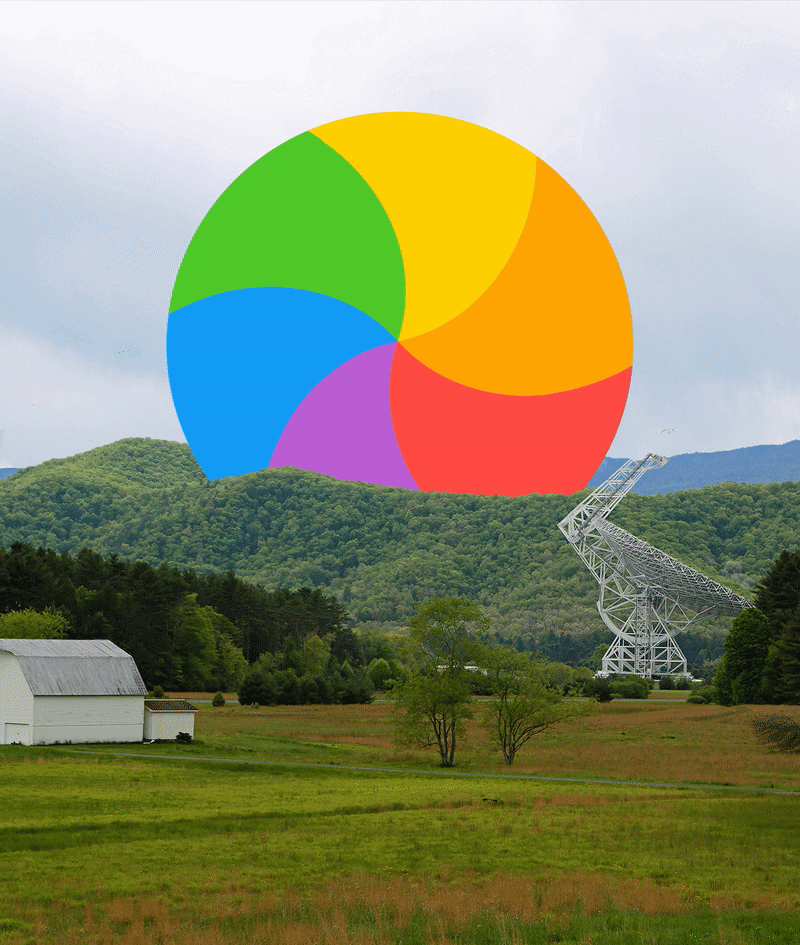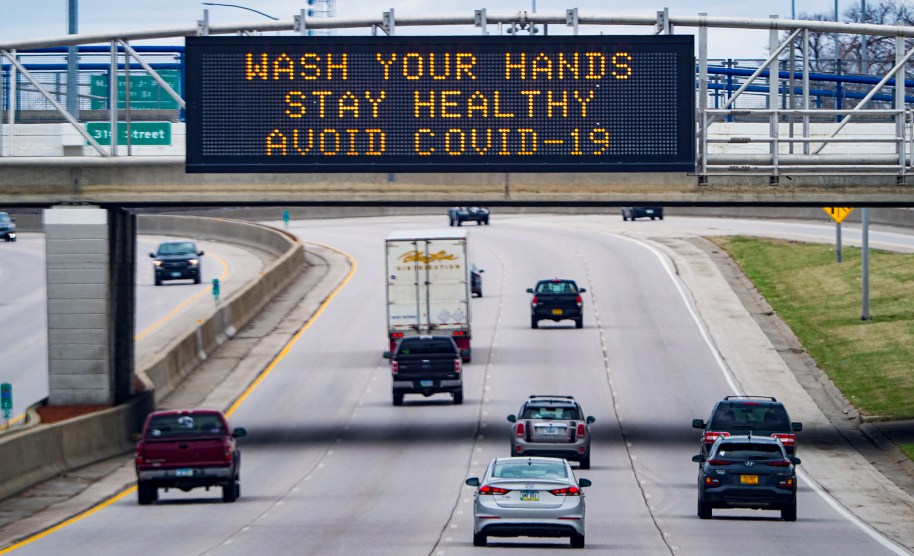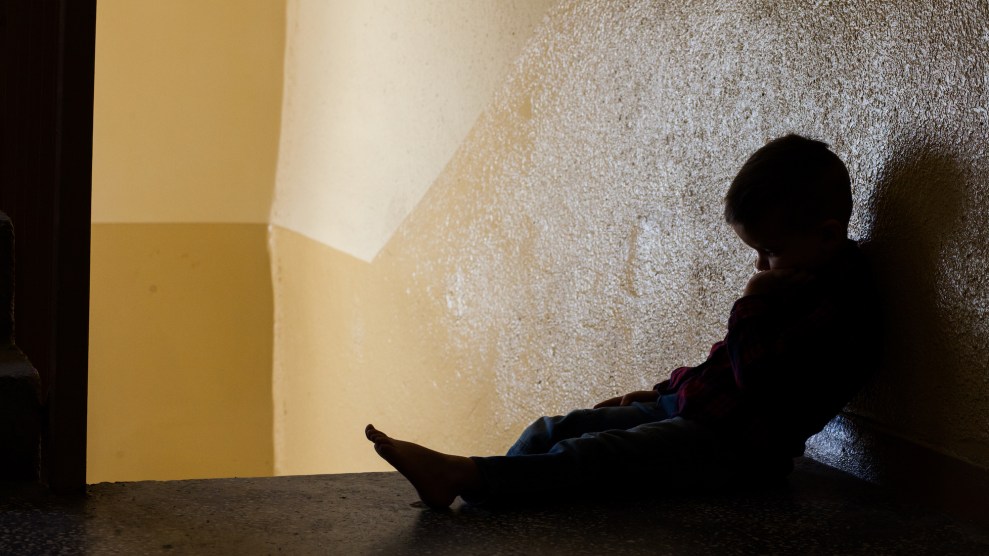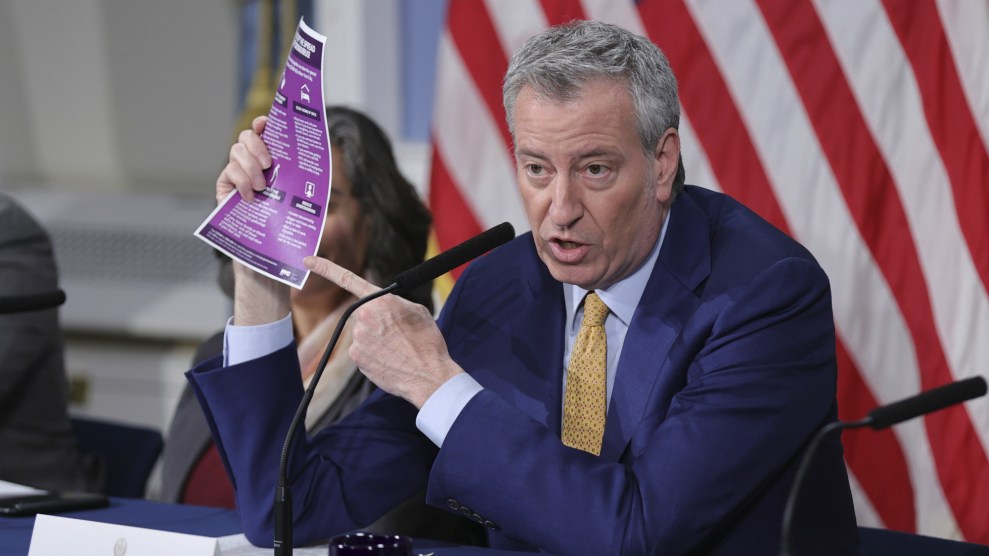Some of the slowest internet in the country can be found in Pocahontas County, West Virginia. That’s because of the telescope at the Green Bank Observatory, nestled into the rolling Alleghenies right below the state’s eastern panhandle. Wifi, cell phones, radio, and even microwaves are prohibited within a 10-square-mile radius of the telescope, which is deep inside of a rectangular 13,000-square-mile piece of land known as the National Radio Quiet Zone (NRQZ), which was established in 1958 to protect the Green Bank telescope and another one in Sugar Grove, West Virginia, from interference.
If she wanted, Grace Beverage, 15, could blame the telescope for her recent F in honors science. She and her twin sister, Melinda, live in the town of Green Bank, inside the Quiet Zone. Since Pocahontas County High School was closed on March 13 in response to the coronavirus crisis, all of their classes have moved online. With their old-school hardwired connection, which relies on their telephone landline and which is slower than cable or fiber-optic internet, they struggle to keep up. Grace learned about convection currents, built an earth science device, and recorded the weather at her house for five days straight. But she couldn’t turn in her completed assignment because there were multiple pages to it, and the connection repeatedly timed out. She received a zero, and the straight-A student watched her grade tank.
Hear from teachers, a student, and a librarian in Pocahontas County, West Virginia, where widespread internet slowdowns have made distance learning almost impossible, in this edition of the Mother Jones Podcast:
Since you are reading this, you are probably among the approximately 85 percent of American adults with access to high-speed internet, able to download, stream, tweet, and access emails without thinking much about it. Now imagine what it’s like when you’re traveling through a tunnel; or trying to stream the Super Bowl at the same time as everyone else; or standing in that random dead zone in your neighborhood. Or when you are at a picturesque lake house and the internet seems to operate according its own circadian rhythms. That’s what online life is like all the time for the other 15 percent of Americans for whom internet access is not a given, either because it costs too much or the technical infrastructure does not exist. Fifteen percent of the students in Pocahontas County have no internet access; 30 percent have no devices that connect to the internet. For those who do have internet at home, the connections are agonizingly slow.
The coronavirus has revealed the level to which American society relies on the internet in general, but especially in a time of crisis. Internet bandwidth usage is up, on average, by about 40 percent since the COVID-19 closures. Within a matter of weeks, nearly every educational institution in the country, from elementary schools to graduate programs, shut down their campuses and moved online in an effort to “flatten the curve” of the pandemic. Teachers are encouraged to keep instruction going by using a patchwork of distance-learning technologies, a task further complicated by the widespread closure of the public libraries that schools and local governments typically rely on to bridge the divide between digital haves and have-nots. It has been an arduous process for teachers and students everywhere. But in the shadow of the Robert C. Byrd Green Bank Telescope, that midcentury monument to scientific progress, it is all but impossible.
“I’m so scared that we’re not preparing our students for a technological age here,” said Samara Mann, who teaches English at Pocahontas County High School. “I read wonderful articles about what other teachers are doing online, and I think, that’s wonderful for you because you can get your students online.”

Pocahontas County is the most sparsely populated county east of the Mississippi River. It’s rural and mountainous, with the gentle Greenbrier River cutting through it north to south. Mann lives next to the Monongahela National Forest, where 8,000 acres of hardwood forest and spruce trees stretch uninterrupted over hills and hollows. At night, she sees a sky full of stars. The nearest Walmart is 45 minutes away.
The economy in Pocahontas County relied on a thriving commercial timber industry for most of the 20th century, but the Great West Virginia Flood of 1985 did catastrophic damage from which the timber industry never recovered. Now, a little over 17 percent of the county lives below the poverty level. The population is slowly shrinking and getting older. One in four jobs is generated by the tourists who come through to hike and camp in the forest, ski at Snowshoe Mountain, and, of course, visit the gigantic telescope at the Green Bank Observatory.
The telescope is quite a sight. Taller than the Statue of Liberty, it’s the largest steerable radio telescope on the planet, almost 17 million pounds of criss-crossing white aluminum beams looming over the rural landscape. It looks like a Cubist deconstruction of the Eiffel Tower, or a robot scorpion. When most people think of telescopes, they think of optical telescopes, which are for seeing far away. This telescope is a radio telescope. It is for hearing far away.
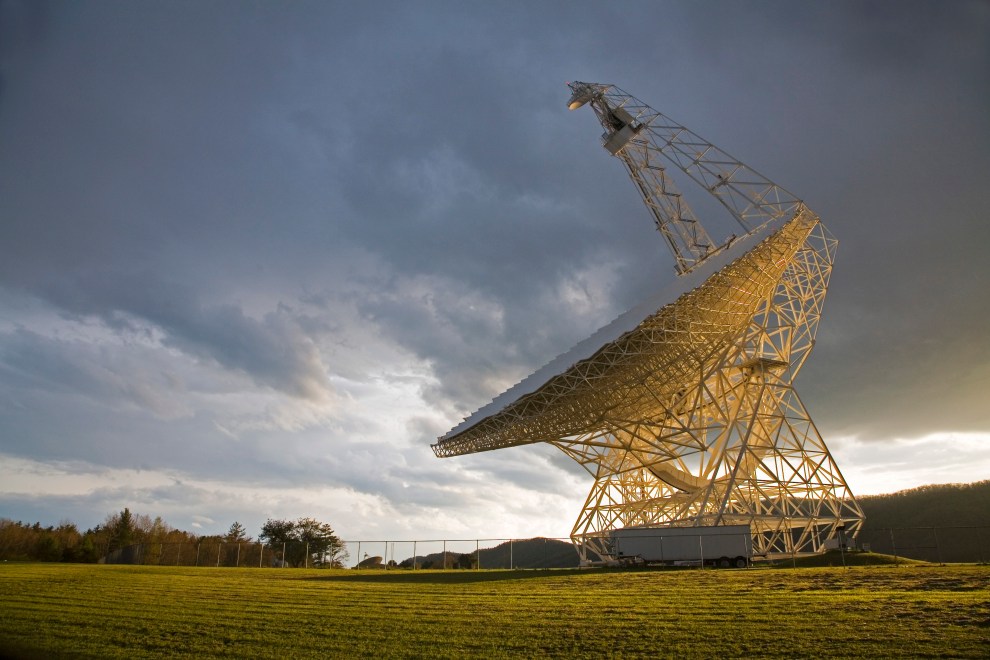
The Robert C. Byrd Green Bank Telescope, at the National Radio Astronomy Observatory, is the largest fully steerable radio telescope in the world.
Jim West/Zuma
In 1955, in the first furlong of the United States’ space race with the Soviet Union, the National Science Foundation decided to invest in radio astronomy as a scientific discipline. A committee unanimously chose Green Bank as the site for a new National Radio Astronomy Observatory specifically because its geography so naturally sheltered the town from radio interference. In a 1956 history of the Green Bank Observatory, Richard Emberson wrote that among sites under consideration, Green Bank stood out because it had by far the least amount of radio connectivity:
“The radio-interference measurements showed that the Green Bank site was in a class by itself….The steering committee unanimously recommended the selection of the Green Bank site for the proposed observatory.”
One of the earliest advocates for the Green Bank telescope was Vannevar Bush, a philosopher scientist. This was the same guy who in 1945 wrote a visionary essay for the Atlantic called “As We May Think,” which imagined the internet 44 years before it existed. “Consider a future device,” he wrote, “in which an individual stores all his books, records, and communications, and which is mechanized so that it may be consulted with exceeding speed and flexibility. It is an enlarged, intimate supplement to his memory.” That the telescope he championed would impede the supplement he envisioned is an irony some locals might appreciate, if only they could get the Atlantic’s website to load.
Since breaking ground on the Green Bank Observatory in 1957, scientists have made mind-blowing discoveries in this “valley of telescopes.” They’ve used their high-powered receivers to find molecules in deep space and detect black holes and show that gravity in other galaxies are made up of dark matter. But making these discoveries requires picking up on teeny tiny wavelengths. A quasar is a star so bright that it eclipses galaxies, with such a concentration of energy that it could contain a black hole. But the typical quasar gives off a billionth of a billionth of a millionth of a watt per square meter. That’s why radio telescopes require a massive dish, like the 2.3-acre reflecting area on the Green Bank telescope, to hear this cosmic static. These radio telescopes need to be powerful enough to detect the energy of a snowflake hitting the ground. And that’s why residents in Green Bank are not supposed to have cellphones.
The very qualities that made the mountainous half of Pocahontas County ideal for a super-sensitive radio telescope also make it difficult for the students living there to access modern technology and get online. “When I announce that we have to do any internet-related something, you see kids, in multiple rows, shaking their heads,” Mann said. “And then multiple kids speak up at the same time saying, ‘That is not going to work for me. My internet is not going to reliably do anything.’”

On March 13, all the normal routines of Pocahontas County High School disintegrated into complete chaos.
The day before, a Thursday, the principal had alerted 31 teachers by email that they should probably prepare for early closures the following week. As it turned out, the governor closed schools the following day, meaning the teachers had less than 24 hours to figure out how to improvise a new distance-learning program and send 299 children home with three weeks of lesson plans. On top of it all, Friday was the day that grades were due for the previous quarter.
Samara Mann likes to over-prepare. She woke up at 5:30 a.m. that Friday, her mind racing with ideas for lesson plans. She could assign book reports. True Grit for the first-years, Animal Farm for the seniors. She grabbed a protein bar, filled her travel cup with Earl Grey tea, and drove 10 minutes to Pocahontas County High School. When she pulled into the parking lot, it was empty except for the lone driver’s ed car. She had never been at school so early before. She poured her tea into a mug and made a beeline for the main office so she could commandeer the fast copier before anyone else started using it, because, as she said, “I just knew the crazy was going to hit.”
The traffic jams at the copy machines got bad that day as the faculty furiously printed and copied and stapled together paper packets for their students to take home. Sending or receiving assignments over the internet would be difficult given the huge disparities in access and the overburdened sole carrier. To make matters worse, the wifi went down at school. No one knew how long school would be closed. As news trickled in, the principal made announcements over the intercom.
The night before, Ruth Bland, director of the Pocahontas County Board of Education, had an emergency situation on her hands. The Pocahontas County High School girls basketball team had miraculously qualified for the state basketball tournament; they were on their way to Charleston to compete against schools many times larger. A spirit bus packed full of fans and fellow students was on its way with them.
Bland wears many hats, including director of school transportation and the county’s technology coordinator. First, she radioed the driver to stop and return the kids to school, which was complicated because the bus was in an area with no cell service. After getting the caravan to Charleston turned around, she had to call the principals of all five county schools and mobilize a countywide K–12 distance-learning program in under 24 hours. “We’re building the airplane as it’s being flown,” Bland said. “We’re teaching the teachers the technology now, and they’re teaching the parents.”
After lesson plans were copied, teachers cobbled together an ad hoc communications network out of various platforms available to them—Microsoft Teams, Zoom, Skype, private Facebook groups—to reach students. Parents were forced to use technologies they’d never touched and had to learn multiple systems if their kids attended different schools. For months, Bland had been nagging teachers and parents to update their computers and learn how to use these applications. Now she was having a major “I-told-you-so” moment, though she sympathizes with the struggles of teachers, parents, and students. And then there’s the problem no one has control over—“The fact that we have unreliable internet makes it very, very difficult,” Bland said.
“Our children really need to understand the technology because they’re stepping into a technologically equipped world, and we need to teach them that,” she continued. “But it’s not just a disservice to the children. It’s a disservice to our self-employed people that have cottage industries here in Pocahontas County, it’s a disservice to law enforcement, it’s a disservice to our [Emergency Medical Services].”
Schools across West Virginia have been closed now for nearly three weeks. Closures have been extended to April 30. Many students finished the last lessons in their packets on Friday, but they weren’t able to turn them in. School administrators decided not to collect the packets for fear of transmitting the coronavirus through the paper. Since the shutdown, the slow internet in rural West Virginia has gotten a lot slower. Everyone is using it at the same time, straining the limited bandwidth, which means that students are spending a lot more time sitting in front of the computers, watching progress bars and spinning wheels, telling them that their data is buffering, or their assignment is loading—and they have to wait. Mann has students in tears, calling her to say that their 10-page research papers didn’t save because it took the internet too long to sync on Microsoft Teams.

With a $13 million operating budget, Pocahontas County schools are cash-strapped and don’t have the money to implement the one-to-one initiative—one technological device per child—that is Ruth Bland’s long-term goal. There are more immediate needs, in any case. Because so many students were on free or reduced-cost lunch, the school system qualified for the Community Eligibility Provision; the county provides free breakfasts and lunches for all students at each of its schools, five days a week.
During the shutdown, Bland has been working overtime with the county’s service staff to distribute 5,960 meals to its students, each breakfast and lunch separately packaged with labels and heating instructions. They have to start working at 6 a.m. to be ready for distribution at 10 a.m. Bland said that if this didn’t happen, many kids would go hungry. Some students pick up multiple bags for their families at home.
Pocahontas County schools depend on federal funding from the USDA Forest Service as part of the Secure Rural Schools and Community Self-Determination Act, which is a bill that provides funds to states and counties with designated national forests that prohibit people from building, thereby shrinking the potential tax base. The idea is that this funding helps counties recoup some of those lost taxes to use for things like schools. But the funding has decreased significantly over the past 20 years. There are regular fights in Congress to cut this funding, and it’s once again under threat.
“If you were in a populated area and you lost that funding, it would be like cutting off their little toe,” Bland told me. “With us, it’s like cutting off our leg.”

For teenagers in Pocahontas County, this waiting has taken on the form of the Google dinosaur that pops up and says, “Unable to connect to the internet.”
Grace and her twin sister, Melinda, have started waking up at 2 a.m. to turn in their homework. They’re hoping that the internet will be faster in the middle of the night, when no one else is using it. Grace is tired of watching the progress bar load to 75 percent—before her assignment fails to send and the waiting starts all over. Melinda is bored with hanging around the house all day. She wants to get back to school, where she had planned to try out for the softball team, and looked forward to analyzing music lyrics in English class with Samara Mann every Tuesday.
“When I try to type on a Word document, I have to refresh so many times,” said Kelly Pyne, 18, a senior in Mann’s college English class. “I tried submitting a scholarship, and it said ‘still pending’ for an hour or so.”
Pyne has a full schedule of schoolwork, including two AP classes. Sometimes her internet crashes while she’s trying to submit assignments. Sometimes her applications tell her that the file she’s trying to send is too large. Sometimes her browser tells her the page won’t load. Plus, she’s still working as a cashier at the Route 39 gas station, where she and her co-workers have started carrying around a bucket of bleach and bleaching everything down. Under quarantine, Pyne is busier than ever. The slow internet makes it harder to check the many items off her to-do list.
Pyne doesn’t see her offline upbringing as a net negative. She’s glad that she learned how to navigate life without the internet. She sees a lot of tourists pass through the gas station where she works, on their way to Snowshoe Mountain or the Monongahela National Forest or the Green Bank Observatory, helplessly trying to figure out directions because they are so reliant on their cellphones’ GPS.

The McClintic Public Library sits on a little bit of a hill. Clusters of daffodils are blooming in the parking lot, their sunny yellow faces drooping against black pavement. The library closed its doors to the public on March 17. But even though the doors are locked, there are always a few cars posted up in the parking lot these days. That’s because people have been coming here to connect to the library’s wifi.
In 2019, there were 3,800 public wifi logins and 8,700 public computer uses at the five branches of the Pocahontas County libraries. The library system has 5,460 library card holders, which is significant for a county of around 8,400 people. The public computers at the five branches are normally in constant use, and wifi is available at four of them. (Only the Green Bank branch, which is inside the NRQZ, has no wifi.)
As soon as the libraries closed, Cree Lahti, director of the Pocahontas County libraries, got to work trying to figure out how to keep providing access to the internet. The branches opened up their wifi and made it accessible from the parking lot. Sitting in some of the parked cars are students accessing wifi and turning in assignments.
At first Lahti and her staff taped six tickets with wifi passwords on the front and side doors of McClintic Public Library. With so many people taking the tickets, it became clear the system was unsustainable. So Lahti called the folks at the West Virginia Library Commission, and they remotely opened up access so that logging on to the Pocahontas County Libraries’ wifi no longer required a password. Now, anyone can come and access it at any time.
For people living in areas with spotty internet connections, the mass migration online has left them behind. This is more common in rural areas, though it’s not exclusively a rural problem. According to the Pew Research Center, 50 percent of eighth graders in rural areas do not use internet at home to do their homework on a daily basis. Twenty-four percent of lower-income teens don’t have the resources to use the internet at home, which goes up to 25 percent for Black teens. About 12 percent of teens surveyed use public internet to do their homework. That number jumps to 21 percent for teens in low-income families.
In many communities public libraries are the only place with free, reliable access to the internet and computers. But now, like schools, public libraries are closed to patrons. They’ve been deemed nonessential businesses in West Virginia and around the country, which means that for students who need to do a lot more online right now, accessing the internet is even harder. The digital divide is not a new problem; the coronavirus has simply exacerbated the consequences. Huge chunks of the population now live in something like a quiet zone.
Bland remains optimistic that Pocahontas County will get through this pandemic intact. So far there are no cases of COVID-19 in the county, and its chances of keeping the coronavirus out are helped by the fact that everyone lives so far apart. Many families have their own vegetable gardens and livestock.
Bland has started leaving eggs from her 30 chickens on a table outside her house with a little bag in which neighbors can leave money, because eggs in the grocery store have been hard to come by. Derek Trull, a middle school science teacher at Green Bank Elementary–Middle School, has been staying up late at night, sewing face masks according to CDC specifications and dropping them off at the Pocahontas County Memorial Hospital.
But with the lack of internet access jeopardizing the long-term viability of their slapdash distance-learning program, the residents of Pocahontas County are confronting the limitations of their own resourcefulness. After the internet fiasco of the first two weeks, teachers have cut back the workload by more than half. Students are required to send in only two assignments per week instead of five.
Mann has been seeing other people using Zoom to keep their work meetings and classrooms going. She wants to use Zoom, but she’s afraid to try it because it will probably be an irritation for everybody involved, with people’s faces freezing and their voices lagging way behind. She might give it a shot. She’s hoping that this crisis, as bad as it has been, will be a wakeup call for state legislators to invest in the internet.
“As a teacher this is heartbreaking, disenchanting. You want to reach all the kids. They all deserve the same opportunities,” she said. “If we had had the internet infrastructure for this, this could’ve been an amazing learning opportunity. For everybody.”
Update: The FCC has relaxed regulations, and now the four out of five schools in Pocahontas County with wifi have opened up their wifi as hotspots. Parents and students can now drive to one of these schools and submit their assignments from the parking lot.
